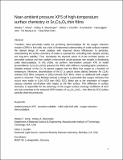| dc.contributor.author | Hong, Wesley T. | |
| dc.contributor.author | Stoerzinger, Kelsey A. | |
| dc.contributor.author | Crumlin, Ethan J. | |
| dc.contributor.author | Mutoro, Eva | |
| dc.contributor.author | Jeen, Hyoungjeen | |
| dc.contributor.author | Lee, Ho Nyung | |
| dc.contributor.author | Shao-Horn, Yang | |
| dc.date.accessioned | 2016-07-15T19:59:47Z | |
| dc.date.available | 2017-03-01T16:14:49Z | |
| dc.date.issued | 2016-02 | |
| dc.identifier.issn | 1022-5528 | |
| dc.identifier.issn | 1572-9028 | |
| dc.identifier.uri | http://hdl.handle.net/1721.1/103628 | |
| dc.description.abstract | Transition metal perovskite oxides are promising electrocatalysts for the oxygen reduction reaction (ORR) in fuel cells, but a lack of fundamental understanding of oxide surfaces impedes the rational design of novel catalysts with improved device efficiencies. In particular, understanding the surface chemistry of oxides is essential for controlling both catalytic activity and long-term stability. Thus, elucidating the physical nature of species on perovskite surfaces and their catalytic enhancement would generate new insights in developing oxide electrocatalysts. In this article, we perform near-ambient pressure XPS of model brownmillerite Sr[subscript 2]Co[subscript 2]O[subscript 5] (SCO) epitaxial thin films with different crystallographic orientations. Detailed analysis of the Co 2p spectra suggests that the films lose oxygen as a function of temperature. Moreover, deconvolution of the O 1s spectra shows distinct behavior for (114)-oriented SCO films compared to (001)-oriented SCO films, where an additional bulk oxygen species is observed. These findings indicate a change to a perovskite-like oxygen chemistry that occurs more easily in (114) SCO than (001) SCO, likely due to the orientation of oxygen vacancy channels out-of-plane with respect to the film surface. This difference in surface chemistry is responsible for the anisotropy of the oxygen surface exchange coefficient of SCO and may contribute to the enhanced ORR kinetics of La[subscript 0.8]Sr[subscript 0.2]Co[subscript O3−δ] thin films by SCO surface particles observed previously. | en_US |
| dc.description.sponsorship | National Science Foundation (U.S.). Materials Research Science and Engineering Centers (Program) ( award number DMR-0819762) | en_US |
| dc.description.sponsorship | MIT Skoltech Initiative | en_US |
| dc.publisher | Springer US | en_US |
| dc.relation.isversionof | http://dx.doi.org/10.1007/s11244-015-0532-4 | en_US |
| dc.rights | Creative Commons Attribution-Noncommercial-Share Alike | en_US |
| dc.rights.uri | http://creativecommons.org/licenses/by-nc-sa/4.0/ | en_US |
| dc.source | Springer US | en_US |
| dc.title | Near-Ambient Pressure XPS of High-Temperature Surface Chemistry in Sr2Co2O5 Thin Films | en_US |
| dc.type | Article | en_US |
| dc.identifier.citation | Hong, Wesley T., Kelsey A. Stoerzinger, Ethan J. Crumlin, Eva Mutoro, Hyoungjeen Jeen, Ho Nyung Lee, and Yang Shao-Horn. “Near-Ambient Pressure XPS of High-Temperature Surface Chemistry in Sr2Co2O5 Thin Films.” Top Catal 59, no. 5–7 (February 11, 2016): 574–582. | en_US |
| dc.contributor.department | Massachusetts Institute of Technology. Department of Materials Science and Engineering | en_US |
| dc.contributor.department | Massachusetts Institute of Technology. Department of Mechanical Engineering | en_US |
| dc.contributor.mitauthor | Shao-Horn, Yang | en_US |
| dc.contributor.mitauthor | Hong, Wesley T. | en_US |
| dc.contributor.mitauthor | Stoerzinger, Kelsey A. | en_US |
| dc.relation.journal | Topics in Catalysis | en_US |
| dc.eprint.version | Author's final manuscript | en_US |
| dc.type.uri | http://purl.org/eprint/type/JournalArticle | en_US |
| eprint.status | http://purl.org/eprint/status/PeerReviewed | en_US |
| dc.date.updated | 2016-05-23T12:16:00Z | |
| dc.language.rfc3066 | en | |
| dc.rights.holder | Springer Science+Business Media New York | |
| dspace.orderedauthors | Hong, Wesley T.; Stoerzinger, Kelsey A.; Crumlin, Ethan J.; Mutoro, Eva; Jeen, Hyoungjeen; Lee, Ho Nyung; Shao-Horn, Yang | en_US |
| dspace.embargo.terms | N | en |
| dc.identifier.orcid | https://orcid.org/0000-0003-1560-0749 | |
| mit.license | OPEN_ACCESS_POLICY | en_US |
| mit.metadata.status | Complete | |
